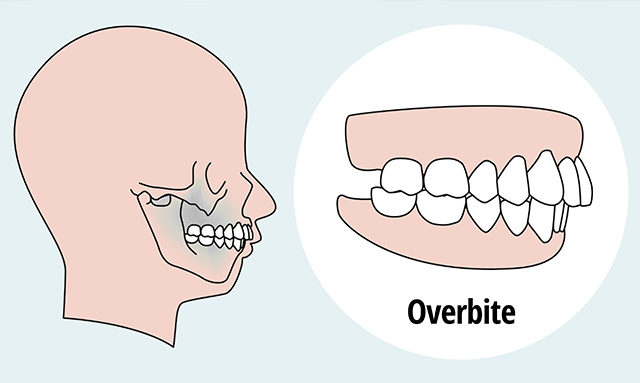I Have an Overbite – What Treatment Should I Use?

Long Beach, CA – If you or your child have an overbite, orthodontic treatment can help improve your bite and the overall health of your smile. But there are so many treatment options to choose from, how can you know which is best for you?
What is an overbite?
Technically speaking, a malocclusion is classified as an overbite when the upper teeth overlap the bottom teeth vertically. In a severe overbite, you won’t be able to see the bottom front teeth at all when biting down. However, when most people speak of an “overbite,” they are usually referring to the horizontal protrusion of the upper teeth over the lower teeth. This protrusion of the upper teeth is called an “overjet.” The way I like to describe it to patients is that the “top teeth are jetting out over the lower teeth.” The cause of an overjet can be a combination of the following: a protrusive upper jaw, a small (retrusive) lower jaw, protrusive upper teeth and/or retroclined lower teeth.
Which treatment option should I choose?
It’s important to remember that not all overjets are created equal, so your treatment plan and the treatment options available to you will be unique to your diagnosis and cause of the overjet. The best way to determine the right treatment option for you is by scheduling a consultation with a board-certified orthodontist.
At your consultation, your orthodontist will take the necessary X-rays and photos, as well as perform a physical exam, to determine the exact issue you are facing. From here, the orthodontist will be able to determine which treatment option will be best to give you your ideal smile.
Traditional braces and Invisalign are the most commonly used orthodontic treatment options to correct the dental alignment and overbite. But for patients with mild to moderate overjet, braces alone will not be enough to correct the overjet. Auxiliaries like rubber band elastics, springs and the Carriere appliance are used in conjunction with braces or Invisalign to help achieve the desired movement and ensure the overjet is corrected.
- Rubber band elastics – These are the most commonly used auxiliaries to correct mild to moderate overjets. While most people associate rubber bands with braces, they can also be attached to Invisalign via the use of elastic cutouts in the plastic and buttons on the teeth. Elastics work to retract the upper teeth and shift the lower teeth forward. When worn as instructed, elastics provide ideal and predictable overjet correction.
- Springs – There are several different types of springs, including but not limited to Forsus and CS5 springs, which can be attached directly to the braces wires and are fixed in place. They act similarly to rubber bands, but provide a consistent force on the teeth since they are not removable. For that reason, springs are a great option for patients who have difficulty placing elastics or are non-compliant with elastic wear.
- Carriere Distalizer – The Carriere works to shift the lower teeth forward while also moving the upper teeth back. The appliance consists of curved bar that is attached to an upper canine and first molar. An metal button attachment is bonded on the lower first molar, and elastics are worn from top to bottom to move the teeth into proper alignment.
Patients with more severe overjet and skeletal malocclusions, however, will require the use of additional appliances, such as the MARA or Herbst Appliances. These appliances attach directly to the teeth and help guide the growth of the lower jaw forward. Because they work on jaw growth, these appliances are not options for a non-growing adult patient.
- MARA Appliance – The MARA is a fixed orthodontic appliance that works to move the patient’s lower jaw forward so that the top and bottom teeth will meet properly. When functioning correctly, the only way for the patient to bite down with the MARA in place, is to slide their lower jaw forward. With time and jaw growth, bite correction will occur as the bottom jaw grows forward to align with the top jaw.
- Herbst Appliance –The Herbst is a fixed brace that positions and moves the lower jaw forward. Metal rings are cemented to the upper and lower first molars, and then rods called jigs are inserted to connect the molars. These jigs bring the lower jaw forward, stimulating jaw growth.
The process to correct overbites in adults is different than in younger patients. Adolescent patients have the advantage of jaws that are still growing, making it much easier to achieve the ideal bite. Many adult patients can still use braces or Invisalign with elastics to improve their smiles if the overjet is mild to moderate. For those with a severe overjet, jaw surgery or extraction of two upper premolars may be required to help get the smile in proper alignment. Jaw surgery will involve moving the lower jaw forward, and in some cases, repositioning both the lower and upper jaws.
Overjets are one of the most common orthodontic issues, and with the right orthodontist, they are easy to correct. Most patients will be able to achieve their ideal smiles with the use of braces or clear aligners with elastic wear. To determine the best course of treatment to correct your or your child’s overjet, schedule a consultation with a board-certified orthodontist today.

